OAXACA DE JUÁREZ
Tourism in OAXACA CITY
Oaxaca City, the state capital, is famous for its architecture and for its rich cultural traditions. Oaxaca is also graced by a splendid and varied cuisine and spring-like weather year round. UNESCO declared the city a Cultural Heritage Site.
Oaxaca is the most diverse state in Mexico. It has peaks that reach more than 3,000 meters high, caverns that are among the deepest in the world, virgin beaches, secluded forests, and sunlit valleys. Oaxaca is rich in traditions and customs and has the largest ethnic population found in Mexico.
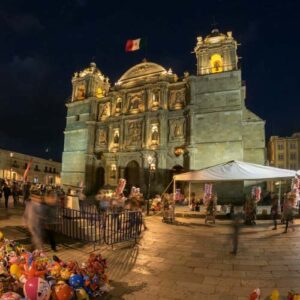
The historic heritage catches the eye when traveling through the city; you can visit the ancient Main Plaza, the Government Palace, the art nouveau-style kiosk, the Cathedral with its baroque façade and the portals with stores and restaurants. The cafes that line the sidewalks are a favorite spot of locals and tourists alike. Here you can enjoy, under the shade of huge laurels from India, the famous chocolate from Oaxaca as well as the mezcal with orange juice and worm salt. This is also a common venue for concerts or fireworks displays.
Oaxaca’s museums and galleries hold many of the region’s most valuable treasures: from the jewels of Monte Albán to contemporary internationally distinguished artists. The small storefront art galleries are replete with wonderfully unique and provocative offerings. And the markets offer an incredible variety of colorful designs. Oaxaca is one of the richest places for arts and crafts in Mexico. Climate goes from semidry-semiwarm in the valleys, to humid in the east mountain chain. The average year temperature in the city of Oaxaca is 22ºC.
Map of OAXACA CITY
TOUR 1
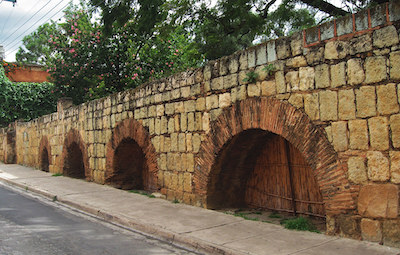
Xochimilco Archs
This aqueduct was built between 1727 and 1751. These green-quarry stone arches are approximately 300m long. The aqueduct lines the road to San Felipe del Agua, ending just at the corner of the Carmen El Alto Temple. Today to the corner of, long strips of the aqueduct remain wholly intact. It’s a pretty section of the city for a stroll.
Oaxacan Institute of Handcrafts (A.R.I.P.O)
It is located in a nice colonial mansion. The greatest variety of handicrafts made in the state are exhibited and sold within this shop. All the objects are of good quality.
“Casa de Juárez” Museum
This is an 18th century building. It belonged to someone named Antonio Salanueva, but Juárez lived here during his childhood, after his arrival from San Pablo Guelatao. The museum displays documents related to his presidency, ordinary artifacts from that time period, some of which belonged to Juárez, as well as furnishings designed to recreate the environment of that period. Open Tuesday to Sunday from 10:00 to 19:00 hrs.
The Church and Ex-Monastery of Del Carmen Alto
The complex were completed at the end of the 17th century. The Carmelite Temple and Monastery was built in the same place and with the stones of a pre-Hispanic pyramid. The name “Alto” (high) was because this was a temple exclusive for persons born in Spain or of pure Spanish descent, “criollos”. There was another temple named “Bajo” (Under) for people with mixed ancestry, mestizos, and mulattoes, since during the colonial time the caste system was fierce and strict. In the façade there is an impressive relic of the Virgin. The interior has been remodeled several times. South of the church is The Plazuela de Carmen Alto.
Graphic Arts Institute of Oaxaca (Instituto de Artes Gráficas de Oaxaca)
Its collection shows the best of the universal and contemporary graphic art. The institute was founded by famous artist Francisco Toledo, and hosts a large collection of artwork from all Latin America. It has a library, a photography center, a store and a gallery. Open daily from 9:30 to 20:00 hrs.
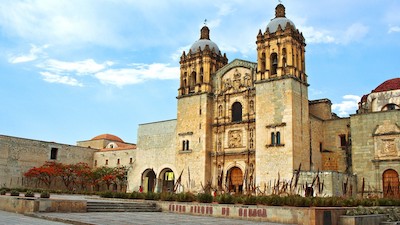
Santo Domingo Cultural Center (Centro Cultural Santo Domingo)
This complex is located in the former convent of Santo Domingo, this is a not-to-be-missed sight on a visit to Oaxaca. Here is the Museum of the Cultures of Oaxaca; the Nestor Sanchez Periodicals Library, with an auditorium where exhibitions, conferences, forums and concerts are held; the Francisco de Burgoa Library with a collection of over thirty thousand volumes published between 1484 and 1940; and the Ethno-botanical Garden with more than a thousand species of the various Oaxacan environments from the most humid to the most arid. There are guided tours highly recommended for anyone interested in plants, natural history and culture.
The Museum of Oaxacan Cultures (Museo de las Culturas de Oaxaca)
It is housed in the beautiful monastery buildings adjoining the Church of Santo Domingo. This is the best museum in Oaxaca. The rich displays take you right through the history of Oaxaca. The 14 rooms of the museum feature a valuable collection that offers its visitors an archaeological, historical and ethnographical panorama of the cultures of Oaxaca.
The collection includes the Mixtec treasures from the Tomb VII of Monte Alban with a stash of beautifully worked silver, turquoise, coral, jade, amber and gold. The museum also has interactive multimedia areas to learn more about the popular art and crafts. Schedule: Tuesday to Sunday from 10:00 to 19:00 hrs.
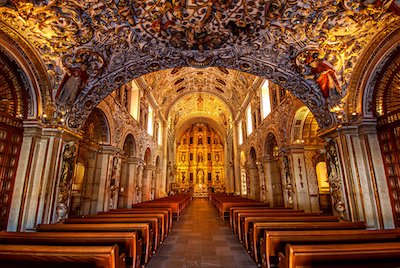
The Church of Santo Domingo
The complex was built mainly between 1551 and 1608. This is an historical architectural monument of the Dominic Order consisting of the Temple, the Former Convent, the Orchard and a spacious cut-stone plaza, slightly elevated from the traffic-free cobblestone streets below. The church is one of the most magnificent examples of baroque in Mexico. It features a strong contrast between the sober exterior and its rich interior.
The walls and ceiling are covered with paintings and murals, much like the Sistine Chapel, it is a dazzling and breathtaking vision. Most of the surfaces -walls, domes, and niches- are covered with stucco ornamentation in bright colors or gold gild. The vaulted entrance is covered with a gilded stucco genealogical tree of Santo Domingo de Guzmán decorated with polychrome paintings.
The Rosary Chapel to the right of the nave echoes the entrance with its statue of the Virgin in the center of many branches. The lavishly-decorated altar with a figure of the Virgin Mary is also considered a jewel of Santo Domingo.
Parish of the Precious Blood of Christ (Templo de la Preciosa Sangre de Cristo)
Originally the site of the city’s first cemetery, the church was built in the 17th century. During the holly week, the walking of the Procession of Silence starts in this church.
Manuel Álvarez Bravo Photographic Center
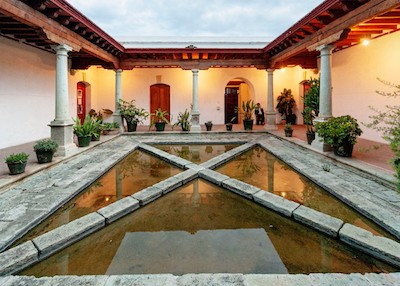
It features a large photographic collection of important authors such as Francis Alÿs, Manuel Alvarez Bravo, Hugo Brehme, Henri Cartier-Bresson, among others. There is also a library specializing in photography; and a Music Library with more than 3,000 recordings of various of various music genres (classical, jazz, blues, ethnic, etc.). Workshops, book presentations and portfolios, and guided tours are offered by the Center as part of commitment to promoting photographic work.
State Public Library
A big building with beautiful corridors and graceful columns of green quarry built in the 17th century. It has 5 rooms with more than 6,000 volumes. This is a venue for cultural events and exhibitions.
Philately Museum (MUFI)
First of its kind in Mexico and the only museum dedicated exclusively to mail art in Latin America. It is located in a beautiful colonial building with the most modern museology equipment, which guarantees preservation and appreciation of these little pieces of history. It has a collection of more than 200,000 pieces from all over the world, arranged in chronological order. The highlights might be the Black Penny, the first mexican stamp, and a collection of Frida Kahlo’s letters to Dr. Leo Eloesser. It has a library and a gift shop. Open Tuesday to Sunday from 10:00 to 20:00 hrs.
Contemporary Art Museum of Oaxaca (MACO)
This colonial house is representative of the constructions of the 18th century. The museum shows masterpieces of Oaxacan painters in its large rooms, such as: Tamayo, Toledo, Nieto, Morales and Aquino among others. The ceiling of the stars is a vault with an interesting work from Francisco Toledo, one of Mexico’s most famous contemporary artists. It also functions as a cultural center, screening films and hosting concerts. Open Wednesday to Monday from 10:30 to 20:00 hrs
TOUR 2
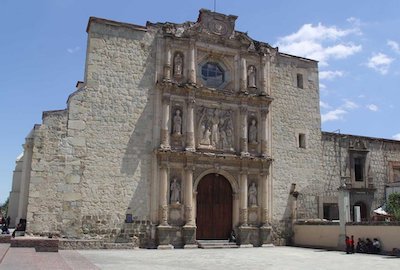
San Agustin Church
The church was consecrated in 1596, but the present building and convent was completed in the 18th century. This is a rather peculiar construction, it is the widest church in the city and don’t have a dome or bell towers. In addition to its handsome sculpted facade, houses the finest assemblage of Oaxacan baroque altarpieces in the city. The interior features three gilded and heavily ornamented altarpieces assembled from statues and paintings, from the colonial period.
Textile Museum of Oaxaca (MTO)
It is located in a fully restored 18th century mansion. This museum aims to promote Oaxaca’s traditional textile crafts, characterized by its colors and beautiful designs, through exhibitions, workshops, films, presentations and a library. The collection consists of almost six thousand pieces from different places and periods. Open Monday to Saturday from 10:00 to 20:00. Sunday 10:00 to 18:00 hrs.
Government Palace
The splendid green quarry building was begun in 1832, and completed until 1887. The large-scale stairways murals by Arturo García Bustos depict famous Oaxacans and Oaxacan history. Open Tuesday to Saturday from 9:30 to 18:00 hrs; Sunday from 9:30 to 16:00 hrs.
Main Plaza / Zocalo / Constitution Park
The plaza has existed since the city was founded in 1529. This is the place to where The “zocalo” is the perfect place for promenades, band concerts and people-watching. This colorful plaza is beautifully shaded, lined with arcades and sidewalk cafes, and teeming with street vendors. The marimba bands play several nights a week. The Night of the Radishes (Noche de Rábanos) is celebrated every year on December 23 in this plaza, as well as the Independence Day on September 16.
Museum of Oaxacan Painters (MUPO)
It is located in a former 17th century mansion. It features spacious rooms where works by national and international artists are on exhibit. Works of Rodolfo Morales, Alejandro Santiago and Francisco Toledo are on permanent display. The museum features various activities like guided tours, children’s workshops, lectures and exhibition of local cultural activities.
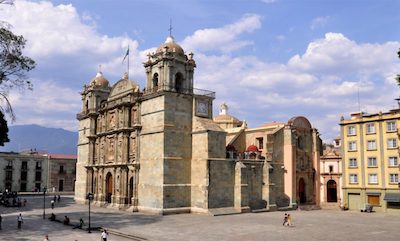
Cathedral of Our Lady of the Assumption (Catedral de Nuestra Señora de la Asunción)
Its construction was begun in 1535, and on July 12th of 1733 it was consecrated. It was dedicated to “La virgen de la Asuncion”, represented with a bronze sculpture made by the sculptor Tadolini and brought from Europe. Its facade is dates back to the 17th century and it is made of green quarry stone. In the interior it has an important painting collection. Among the most important is the canvass depicting Saint Cristobal dated in 1720 by an anonymous artist, and the oil canvasses in the sacristy.
Alameda de León
It is located northwest of the “zocalo”. It was known as the Square of Jars (Plazoleta de los Cántaros) since this was a potters market. Today is a garden area.
Antonia Labastida Park
In 1881 the City Council named this place the “Square of Order and Freedom”, and in 1894 was redesigned as a modern garden. Some years later it was named Antonia Labastida. It is a meeting point for artists and artisans of Oaxaca. Here you will find colorful handcrafts, beautiful altarpieces in scale and artwork at different prices.
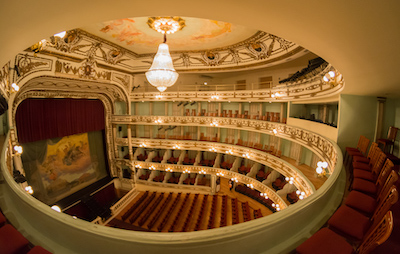
Macedonio Alcalá Theater
This structure was inaugurated on September 5th of 1909. Its Versailles style is characteristic of the Porfirio Diaz period at the end of the 19th century and the beginning of the 20th. The main entrance is on the corner; it has three doors topped with green stone arches. The vestibule is Louis XV style with a white marble staircase and the main hall is in “Imperial” style. On the ceiling is an allegory of the Temple of Art. The curtain has pictorial composition of the Parthenon and Mount Parnassus.
Convent of Santa Catalina de Siena
Dating back to 1577, it has been a Convent, Municipal Palace, jail, and since 1976 the building became a hotel. The main feature is the “Lavaderos”, locate in the center of a nice patio. This is a set of twelve washbasins in an octagonal building crested with a Mudejar cupola. In the restaurant you will find a collection of colonial art.
TOUR 3
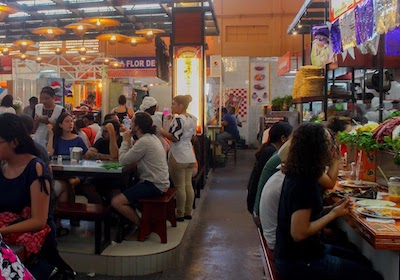
20 de Noviembre Market
The history of the market dates back to the late 19th century. The market has dozens of food stalls where you can enjoy the smells, colors and flavors of the traditional Oaxacan cuisine. Here you will find moles, tlayudas, pan de yema (egg bread), fried grasshoppers, Oaxaca cheese known as “quesillo”, and of course the famous hot chocolate.
Benito Juárez Market
It is the most traditional market in the city. It offers flowers, handcrafts, leather goods, hats and knives. It is also the right place to buy the famous mezcal, moles, quesillos, chocolate and grasshoppers. Here you will find good prices and you can bargain.
Church and former monastery of St John of God (Templo y Ex Convento de San Juan de Dios)
The Hermitage of Santa Catarina Martir was built here, the oldest church in Oaxaca. Because of the arrival of the Juaninos at the end of the 17th century, it was dedicated to San Juan de Dios. The temple’s neoclassical facade has a portal and a tower. The church is best known for its large 17th-century oil paintings, which line the walls depicting scenes from events in the religious life of Oaxaca and the Urbano Olivera paintings on the ceiling.
Handcraft Market
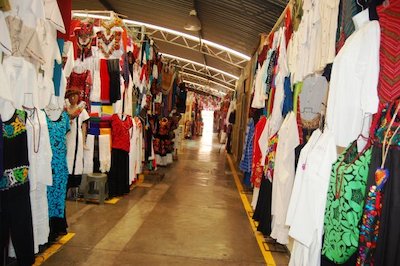
The greatest variety of handcrafts of the State can be found here, such as: Carpets, huipiles, dresses, sarapes, bags and ceramic pieces, among others.
Church of the Company of Jesus (Iglesia de la Compañia de Jesús)
In 1579 the Jesuits arrived to Oaxaca and built this church and convent in honor of the Immaculate Concepcion. When the Jesuits were expelled, the nuns of the Immaculate Conception occupied the temple. Much of the original Jesuit structure is no longer contained within the present building. Columns from the original church exist throughout the block. The facade is in a Baroque-style with Plateresque elements. The main altarpiece covered with gold leaf has kept some of its old traces.
TOUR 4
Carmen Bajo Church
The church constructed on this site in 1554, was named “Las Lágrimas de San Pedro” (Tears of San Pedro). It was the lower church ministered for the indigenous and mestizos populations. The church was heavily damage for an earthquake in 1801 and for a fire in 1862. Its exterior is rich with voluminous designs. In contrast, the interior has a simple decoration with some altarpieces of the 19th century, and some paintings of the early 20th century.
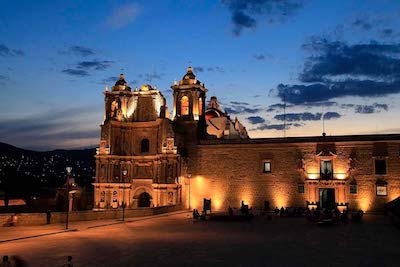
Basílica of Our Lady of Solitude (Basílica de Nuestra Señora de la Soledad)
It was built between 1682 and 1697. The church exhibits an extraordinary richly carved baroque facade resembling a freestanding folding screen; this is a unique design in Mexico’s religious architecture. Inside the church, the rigid, triangular statue of the Virgin of Solitude, declared the patron saint of Oaxaca in 1909, sits perched above the altar.
Every surface of the interior is filled with paintings, reliefs, statues, and stucco ornamentation. The west gallery contains a baroque pipe organ dated 1686. The Augustinian convent was renovated, and today it serves as the Municipal Palace. The Religious Museum attached to the church, contains a curious blend of pieces, it is worth a visit. A huge celebration on and around December 18 honors the Virgin.
San José de Gracia Church
The church was constructed between 1588-1594. It was occupied by the the nuns of Saint Clare de Asis, better known as the capuchinas. Today this building is the Fine Arts School.
Dance Square (Plaza de la Danza)
Located on the foothills of the Fortin Hill. This is a vast open area paved with green quarry stones. It was built for the folklore manifestations.
Sócrates Park (Jardín Sócrates)
It used to be the “Plazuela de la Soledad”. This is a nice place to relax and enjoy a fresh, cool “nieve” or shelbet recognized worldwide for its quality and variety of flavors.
San Felipe Neri Church
This church contains the most extraordinary examples of the baroque with estipite (inverted truncated pyramid) columns from the end of the 18th century. Its golden altarpiece is a wonder of art and beauty. The Churrigueresque main altarpiece, completely intact, dating from the late 1700s, is one of the finest colonial altarpiece in the city covered with ornately carved, gilded wood. There are three large magnificent paintings made by Agustín de Santaella and the noted baroque painter José de Páez. Benito Juarez (former president of Mexico) married Margarita Maza here in 1841.
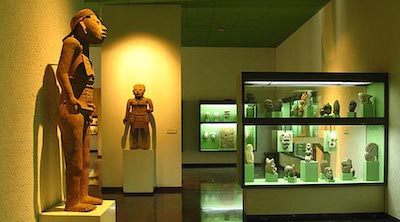
Rufino Tamayo Museum of Pre-Hispanic Art in Oaxaca (Museo de Arte Prehispánico Rufino Tamayo)
A 17th-century colonial building house a collection of over thousand archaeological pieces donated by the late, renowned Oaxacan-born artist Rufino Tamayo. It is considered one of the best collections of pre-hispanic ceramic and sculpture in the country. Open Monday to Saturday from 10 to 14 hrs. and 16-19 hrs. Sundays from 10-15 hrs. Closed on Tuesdays.
Belber Jimenez Museum
Exhibits a private collection of Federico and Ellen Belber Jimenez. There are magnificent pieces of jewelry from the pre-Columbian and colonial era, as well as some works of famous 20th century designers such as Antonio Pineda and William Spratling. There are also some pieces of Folk Art. Open Monday to Saturdays from 10:00 to 17:00 hrs.
San Cosme and San Damian Church
A church built in the middle of the 16th century and remodeled during the 19th century using two different types of quarry.
TOUR 5
Paseo Juárez or El Llano Park
It is one of the oldest and largest parks in downtown Oaxaca. Since the colonial period this park has been a social area where you can enjoy exercising, reading, walking or just relaxing. The park has wireless Internet connection so it is a meeting point for tourists and locals alike. During lent, El Llano hosts “Los viernes del Llano”, a tradition that dates back to the early 20th century. Girls walk around the park and the university students give them roses. The one who collects more roses became a beauty queen.
The Macedonio Alcala Tourist Walkway
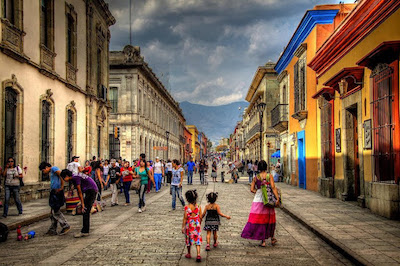
This is the city’s main pedestrian walkway. Walking down the corridor you can find museums, shops, restaurants, temples, galleries, as well as cafes and bars, making for an always- interesting stroll and a lively nocturnal scene.
Shrine of Our Lady of Guadalupe and the Chapel of Bethlehem
It was consecrated on December 12th of 1686. The Betlemitas friars occupied the convent. The Belem chapel was built in 1807 and today is a school.
San Matias Jalatlaco Church
An 18th century building with a simple but elegant façade. The main entrance are decorated with geometric motifs and rosettes carved in quarry stone. It is located in the neighborhood of Jalatlaco, one of the nine neighborhoods of the city of Oaxaca. The place takes you back in time with narrow cobblestone streets lined with low-slung colonial buildings.
Patrocinio Church
There is not much information about this temple. As many other temples in the city, it has been damaged and remodeled several times. The ornamentation of the facade is different from other temples in the city.
More Tourist Attractions in OAXACA
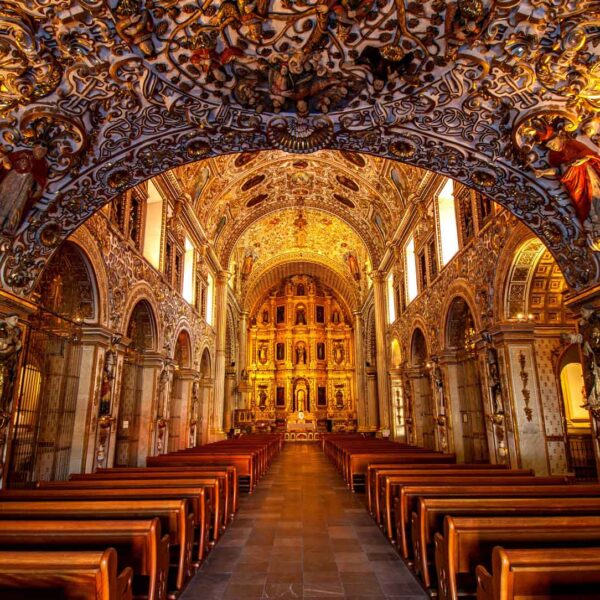
Santo Domingo Cultural Center
The Santo Domingo Cultural Center is a cultural complex that is located in what was one of the most important convents in the colony. It is a large convent in which the Museum of the Cultures of Oaxaca, the Fray Francisco de Burgoa Library and the Ethnobotanical Garden have been established. The Néstor Sánchez Public Newspaper Library is located in a building that is part of the complex but dates from the 19th century.… Read More
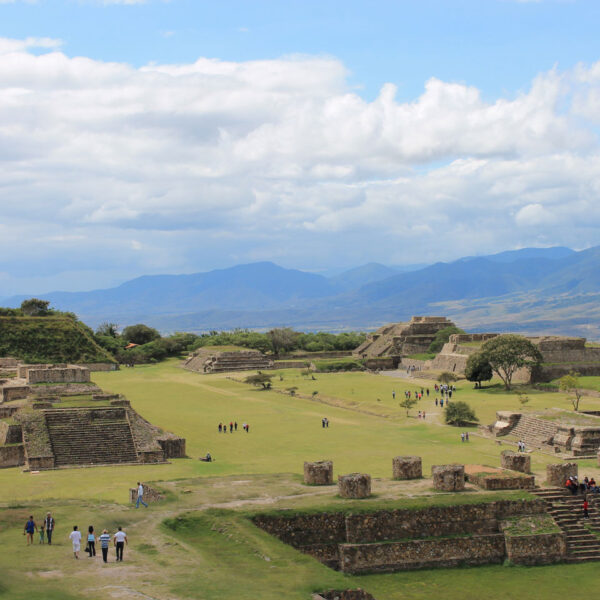
Monte Alban
Monte Alban is the most important archaeological zone of the Oaxacan entity, of unique regional importance due to the religious, political and economic control that the Zapotec state exercised over the population of the Valley of Oaxaca for more than thirteen centuries. It has been named by UNESCO Cultural Heritage of Humanity together with the city of Oaxaca on December 11, 1987. The heritage of the Zapotec world reaches us through the magnificent archaeological sites designed in the Valley of Oaxaca. Of these, the city of Monte Albán stands out for its enormous importance as an economic, political and religious hub (it was the first urban complex in Mesoamerica); by its extension, almost as big as the current capital of Oaxaca; and for its long life, started around 500 BC and concluded around 850 AD.… Read More
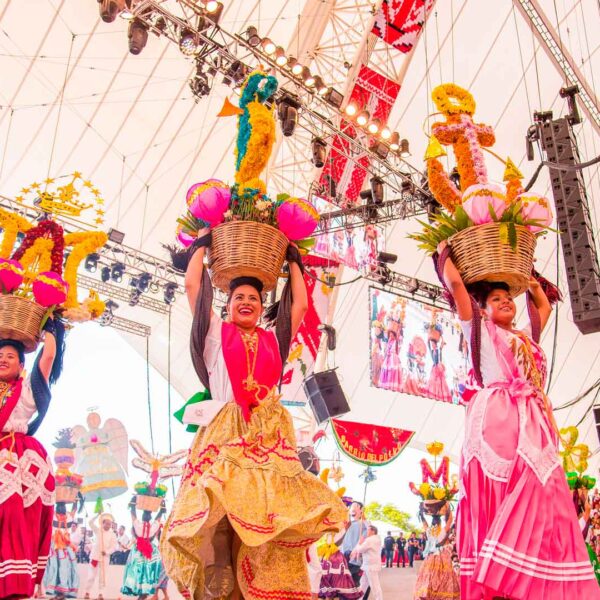
La Guelaguetza
The Guelaguetza is an ancient tradition with pre-Hispanic roots related to agricultural ceremonies of gratitude to the gods for the arrival of the rains and the lifting of the harvest at the end of July and is the largest festival in Oaxaca. La Guelaguetza is a celebration of gratitude for the arrival of the rains and the harvests, in which representatives from all regions of the state gather in the capital to share their culture through dances, crafts and food. La Guelaguetza is celebrated every year on the two Mondays after July 16, except when the first Monday is July 18, Benito Juárez’s death anniversary. Many types of dances also participate, such as the traditional Flor de Piña; where women usually dress in Huipiles representing the different regions of the state, as well as with their pineapple on their shoulders, they comb their hair with beautiful long braids accompanied by their ribbons and can not missing her accessories that is, bracelets, necklaces and earrings of precious colors and her beautiful makeup.… Read More

Mezcal
Mezcal is a rich, handcrafted flavored drink that requires considerable attention to be produced. Mezcal is normally served with white salt or worm salt (salt mixed with a cooked larva and ground chili), lemon or orange. Mezcal production today remains more or less as it was when the Spanish arrived hundreds of years ago. Each “recipe” is transmitted from generation to generation within the families that care about its production; Because each family has its own approach to mezcal production, there are an enormous number of different flavors. It is also in this way that the rich diversity of flavors and traditions are preserved for all to enjoy.… Read More
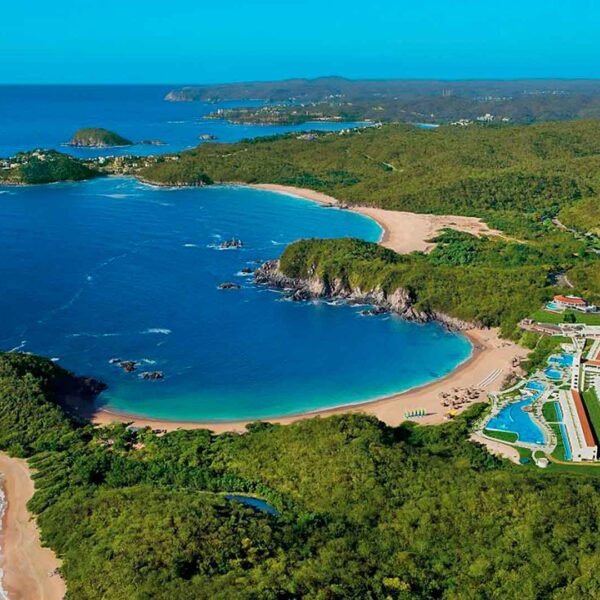
Beaches in Oaxaca
The beaches of the coast of the state of Oaxaca are among the most beautiful and complete in Mexico, thanks to a developing tourist infrastructure and the rich gastronomy of the Pacific. Along the 533 kilometers of coastline, the beaches of Oaxaca offer a wide variety of activities for lovers of water sports: snorkeling, diving, sport fishing, surfing, among others… there is something for everyone!… Read More
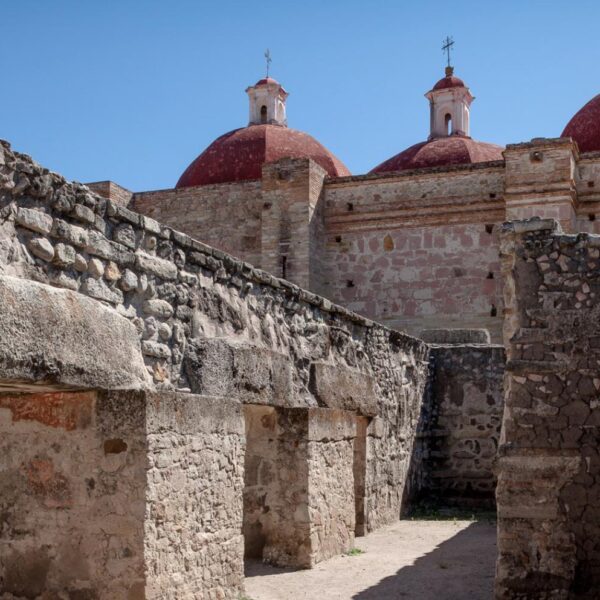
Archaeological Sites in Oaxaca
Oaxaca is famous throughout the world for its archaeological sites and the history they keep. Discover Monte Alban, Mitla, Yagul and more of these remote sites, which have made Oaxaca a World Heritage city, according to Unesco. The original Zapotec and Mixtec peoples of Oaxaca lived in the cities and religious centers of the valley of this city until the time of Spanish colonization. Today, there are still vestiges of these towns and places where you can meet them.… Read More
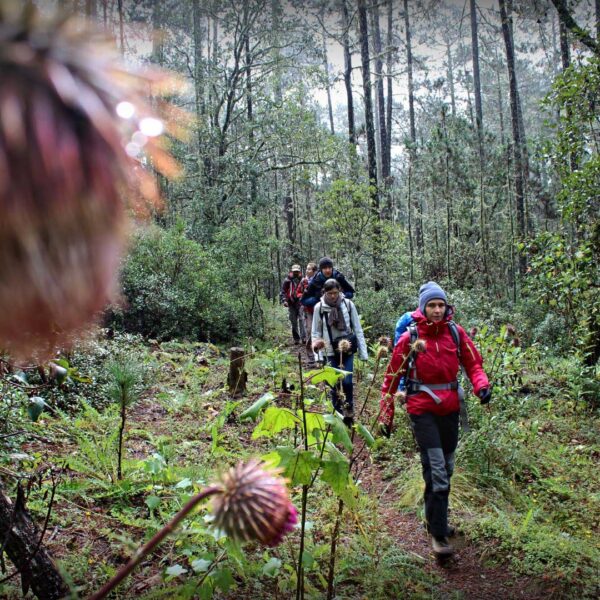
Ecotourism and Adventure in Oaxaca
Oaxaca, located in the southeast of Mexico, is an example of a singular miscegenation that even in the midst of modernity never forgets its origins. In its varied geography, it brings together not only a vast biodiversity, considered among the largest in the world, but also insurmountable cultural and ethnic riches, and the most different and beautiful natural settings. An ideal space for Alternative Tourism, Oaxaca offers activities such as walking, mountain biking, rappelling, climbing, zip-lining, horseback riding, observation of flora and fauna and more, in close contact with nature. The visitor can also witness the various aspects of local life, savor the gastronomy and enjoy the warmth of its people, as well as an offer of accommodation in hotels, ecotourism cabins, local houses or excellent camping areas.… Read More
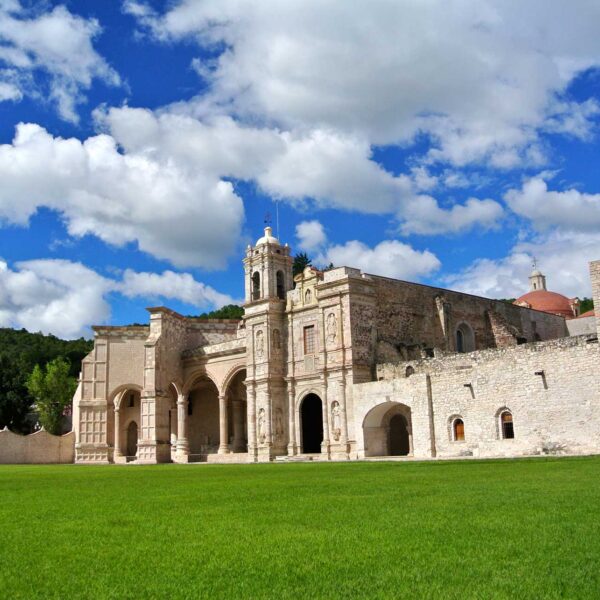
Magical Towns in Oaxaca
In Oaxaca we are proud to have 5 communities that have been awarded the title of Magical Towns of Mexico, a Magical Town is a town that has symbolic attributes, legends, history, transcendent events, everyday life, in short magic that they emanate in each of their socio-cultural manifestations, and that today mean a great opportunity for tourist use. The Magic Towns Program contributes to revalue a group of populations in the country that have always been in the collective imagination of the nation as a whole and that represent fresh and different alternatives for national and foreign visitors.… Read More
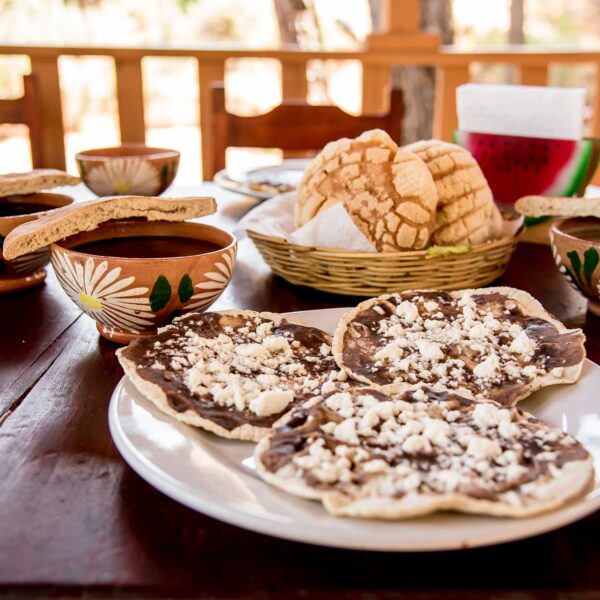
Gastronomy of Oaxaca
The Oaxacan gastronomy takes you on an amazing journey into one of the most outstanding and colorful cuisines in the world. Oaxacan food is among the most varied and delicious in Mexico, UNESCO has declared it Humanity’s Cultural Patrimony. Oaxaca’s gastronomy incorporates elements of pre-Hispanic cuisine, and lively imagination has created combinations that amaze by the color, the aromas and the flavors.
The list of dishes that characterize this cuisine is endless, however, we can mention: Oaxacan Mole in its 7 varieties depending on the type of chili used, Chapulines, (dry roasted, spiced grasshoppers), tlayudas (large tortilla spread with the remaining of the lard and beans), maguey worm sauce, chiles rellenos (stuffed chilies), and of course the famous Oaxacan tamales in banana leaves. Oaxaca cheese is a soft white string cheese, which is similar to mozzarella. It is sold in “ropes” which are wound onto themselves into balls, and eaten cold or lightly melted on quesadillas is considered among the best in the world.… Read More
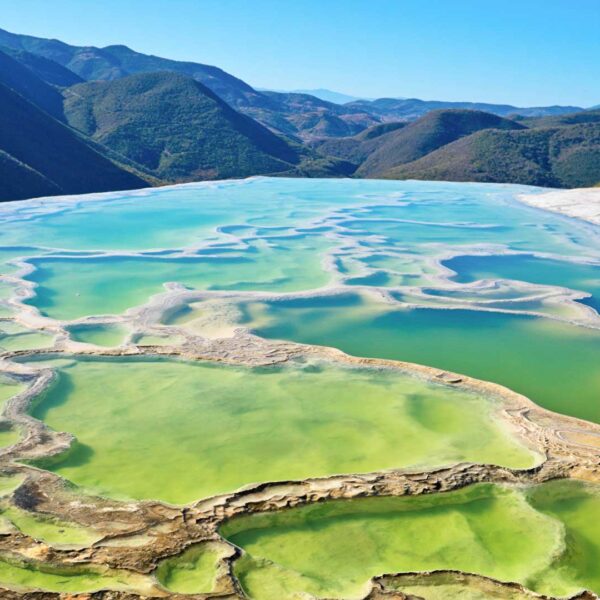
Oaxaca City Surroundings
Oaxaca is a destination that offers a great variety of attractions and tourist charms which leave anyone surprised. When arriving in the city of Oaxaca, the most common is to visit the historic center, the Santo Domingo Temple, the Macedonio Tourist Walk, the gastronomic delights in the Benito Juárez market, the Basilica de la Soledad, among other attractions. And one of the places that you cannot miss is the Monte Alban archaeological zone, which is approximately 30 minutes by car from the historic center. However, there are other places that are also worth knowing and are in the surroundings of the city. For this reason we recommend the following tourist routes.… Read More
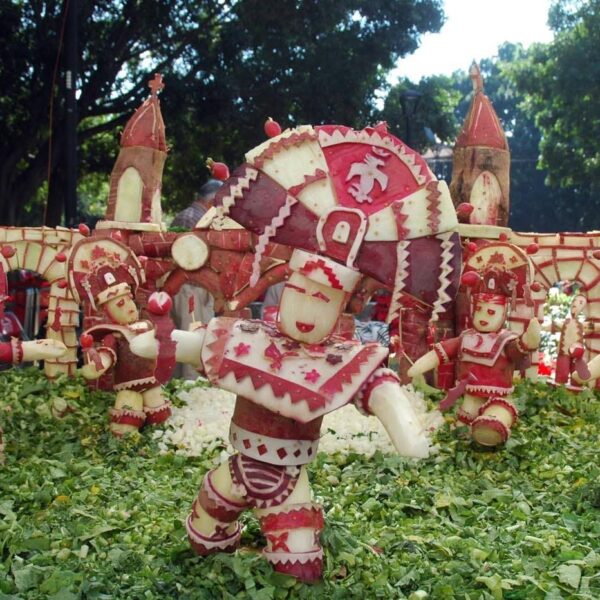
Traditions of Oaxaca
In the state of Oaxaca there are many customs and traditions throughout the year, and within the state, said that they have the same purpose of celebration but with different things, in fact from one region to another or even more from one town to another, the Customs vary for perhaps details but that is what makes them authentic. All the holidays are celebrated, the profane and the religious ones. The festival calendar is extensive due to the diversity of ethnic groups, which they still conserve. Oaxaca has a combination in its traditions of the culture of the ancestors and the current culture, a state that does not lose its customs, adapts them to new times and needs.… Read More
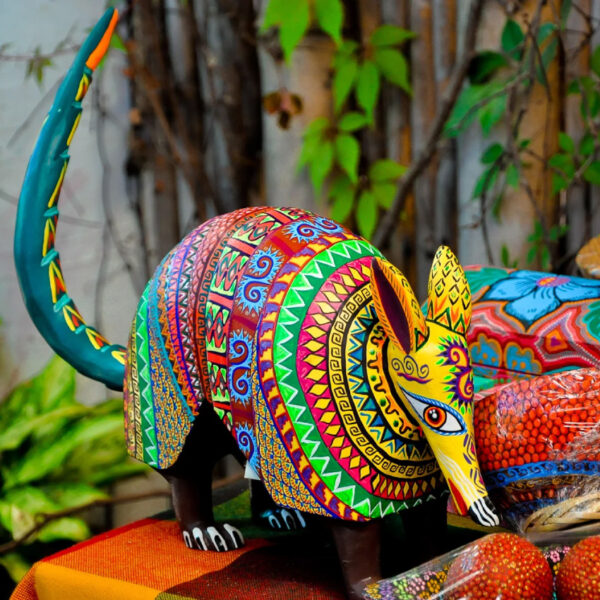
Handicrafts from Oaxaca
Handicrafts from Oaxaca are a great tradition and they offer a diversity that denotes the artistic richness and imagination of its people. The talented artisans of Oaxaca make beautiful pieces of clay, textiles, wood, metal, skins and other materials, forming a rich and varied folk art in both decorative and useful items.… Read More
Guided Tours in OAXACA
Flights & Hotels in OAXACA
More Tourist Attractions in MEXICO

Capital Cities
Folklore, gastronomy, literary culture, art and exhibitions, is what you will find in the capitals of the states of Mexico. To the north, colonial Mexico, Puebla, Guadalajara, Guanajuato, the Sonoran desert and the California peninsula. To the east Veracruz and the gulf. To the west Acapulco, Oaxaca and Tuxtla Gutiérrez. And to the south the Riviera Maya and the pyramids of Chichén-Itzá, Tulúm and Cobá in Yucatán, Palenque in Chiapas, the cenotes, and the Central American jungles.… Read More

Gastronomy
The Gastronomy of Mexico has a great diversity of typical dishes, which is why it was recognized by UNESCO as Intangible Heritage of Humanity. The basic and representative ingredients of Mexican dishes are: corn, coriander, chili, beans, piloncillo, nopal and tomato. Mexican cuisine is also characterized by its sauces, which serve as an accompaniment to traditional dishes, prepared based on spices.… Read More

Beaches
On the Beaches of Mexico you can immerse yourself in the intense blue ocean of the Pacific bays, sunbathe on the shore of the warm and transparent waves of the Caribbean Sea in Quintana Roo or even rest on the beautiful coasts of the Gulf of Mexico. Mexican beaches hide wonderful secrets for the traveler. By visiting them, in addition to enjoying the excellent climate and water activities, you can discover splendid archaeological sites and interesting colonial cities without traveling long distances.… Read More

Ecotourism and Adventure
Mexico is one of the best countries for Ecotourism as it has a great variety of flora and fauna, as well as a large number of refuges for extraordinary species. You can enjoy recreational activities of appreciation and knowledge of nature through contact with it, such as: stargazing, observation of natural attractions, wildlife and bird watching. Throughout México there are more than 176 protected natural areas, 5 of them considered by UNESCO as Natural Heritage of Humanity. Just for this and much more, we believe that Mexico is a Paradise for Ecotourism.… Read More

Magical Towns
A Magical Town is a place with symbols and legends, towns with history that in many cases have been the scene of transcendent events for our country, they are places that show the national identity in each of its corners, with a magic that emanates from its attractions ; visiting them is an opportunity to discover the charm of Mexico. The Magical Towns Program contributes to revalue a set of populations in the country that have always been in the collective imagination of the nation and that represent fresh and varied alternatives for national and foreign visitors. A town that through time and in the face of modernity, has conserved, valued and defended its historical, cultural and natural heritage; and manifests it in various expressions through its tangible and intangible heritage. A Magical Town is a town that has unique, symbolic attributes, authentic stories, transcendent events, everyday life, which means a great opportunity for tourist use, taking into account the motivations and needs of travelers.… Read More

States Of Mexico
Mexico has an incredible diversity of landscapes, where the beauty of its beaches, internationally recognized, stands out. In its vast territory of coasts, there are beaches of unparalleled beauty, and colorful landscapes. A large network of first-class hotels and tourist services is available to visitors to these beaches. Mexico is also mystical places, dotted with archaeological testimonies inherited from its original inhabitants. Monuments made by the Mayas, Aztecs and Toltecs are located in magical landscapes, like lighthouses in an ocean of natural beauty. They offer visitors buildings that tell their history, and museums that collect their cultural heritage. And that keep alive ancestral traditions, in ceremonies and festivals, where you can enjoy cultural activities and entertainment.… Read More

Traditions in Mexico
It is practically impossible to make a meticulous, and above all, accurate selection of the places to visit in Mexico. Each place that our country houses is unique and beautiful in its own way. Mexico, with its nearly 2 million km², has a large number of scenarios to offer, as well as endless activities to do. Do not lose your way and enter the places to visit in Mexico. In Mexico, apart from the beaches and its famous archaeological sites, there are many other really interesting sites and activities that you should know. In the surroundings of the main cities you will find places full of culture and tradition, where you can spend relaxing, interesting and fun vacations. On your trip through Mexico you cannot stop obtaining souvenirs, the crafts that are made here are of the highest quality and recognized worldwide. A shopping tour cannot be missed.… Read More

Archaeological Sites
The Archaeological Zones are the cultural past of every Mexican. You will be amazed at the ambient, nature and the environment that surrounds them. Climbing to the top or being around it will take us back in time to admire every detail. México is a country of culture and traditions, many of which we have inherited from the pre-Hispanic inhabitants of this vast territory, although it is true that there were more settlements in the central and southern part of the country, it is also possible to find some archaeological remains in the north.
… Read More

